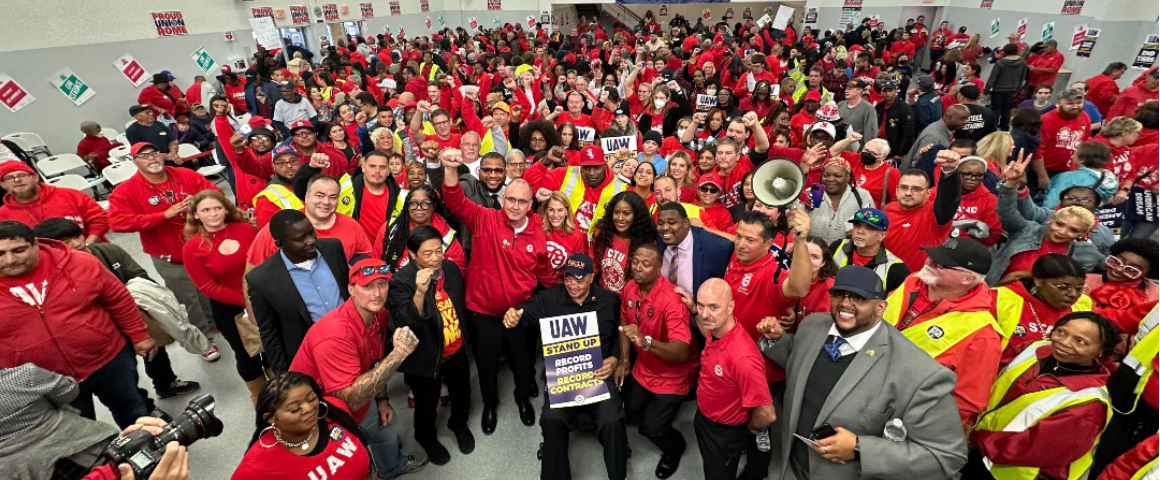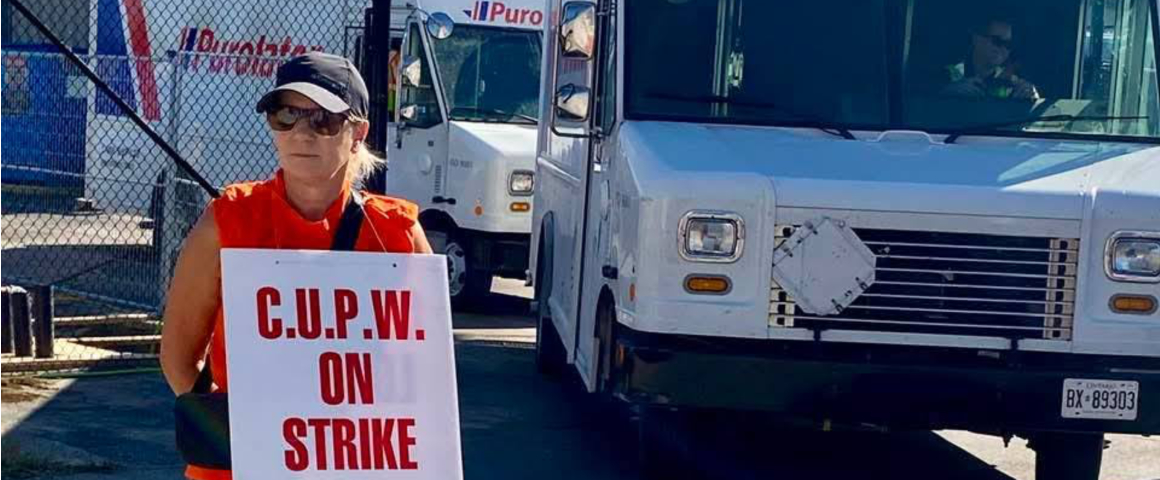By Chris Townshend
[Ed: This article was written prior to the UAW’s new contracts with the Detroit automakers.]
Auto workers employed by the US “Big 3” auto makers – Ford, General Motors and Stellantis (Chrysler) – took strike action on September 15 and tens of thousands of strikers have shut down dozens of manufacturing plants as the union implements its strategy of selective walkouts. The showdown in the auto plants has been brewing for decades as the living standards of the workforce were wrecked and sold out by the corrupt misleadership of the now-ousted United Auto Workers (UAW) “Administration Caucus.”
The revitalization of the UAW union as a real force has been led by completely new elected leadership. Union president Shawn Fain and the Unite All Workers for Democracy Caucus were elected earlier this year with the goal of cleaning up the union and simultaneously winning a good new contract.
Workers fed up
The vast bulk of US working people today are fed up with their steadily falling standard of living and the miserable daily routines which smother them. Poverty, low wages, dead-end jobs, dictatorial bosses, high prices, crushing debt, crime and a near complete lack of any path upwards face more than a hundred million workers daily. Many auto workers today – and virtually all of the younger workers – find themselves in this category. The widespread energetic response to the UAW union strike call at the “Big 3” is solid evidence of this.
These strikes also represent just the tip of an ugly iceberg, since more than 90 percent of the US working class lacks any union vehicle to fight back and therefore still fall behind on a daily basis. Unionized workers can at least try to tread water but the unorganized sink. And keep sinking.
The condition of the auto workforce today is a fine example of just about everything wrong with the current industrial and political order of things, and the current strike rebellion is best viewed through this broad lens. The auto strike also reveals a widespread dissatisfaction with the failed state of business unionism and its sorry “leaders,” as best evidenced by the election of the unknown Shawn Fain. The Fain slate ran openly on the promise of a new direction, a confrontation with the entire old order of things in the union, in relations with the company and with the political establishment.
A new political direction
By the third week of the auto battle, it was inevitable that both Biden and Trump would make attempts to associate themselves somehow with the striking workers. Coming in the wake of his destructive strikebreaking of the rail unions in their bargaining late last year, and his unwanted attempted intervention into the UPS battle, Biden’s attempts to insert himself into the auto fight have so far thankfully been a fizzle. The White House was frantic at the prospect of a nationwide auto strike and mobilized the entire Democratic establishment and its compliant media to try to somehow avoid the showdown by putting public and private pressure on the union. No matter that this strike – as in the other recent situations – has been building for decades and involves a breadth and depth of issues that can only be resolved with the long overdue strike action.
Biden’s strike-eve dispatch of two supposedly high-level emissaries to the UAW – White House economic advisor Gene Sperling and acting Secretary of Labor Julie Su – were both easily snubbed by Fain. The new UAW president ignored this farcical attempt to pressure him into an early and unsatisfactory deal with the companies. Biden renewed his frantic scheme to somehow profit from the strike when it was learned that former President and leading Republican presidential candidate Donald Trump was planning to visit Michigan on September 27. The White House scrambled, and President Biden visited a UAW picket line in Michigan the day before Trump’s visit.
Biden’s obvious cheap publicity stunt was greeted graciously by the UAW, and not much more. The following day drop-in by anti-labour bigot Trump fell even flatter, as UAW president Fain publicly denounced the attempts of the “billionaire class” to insert themselves into the fray.
The UAW has lost more than 1.1 million members in the past 50 years, reduced to around 400,000 members today with only two thirds of that representing manufacturing workers. Biden’s attempts to bestow upon himself the label of “the most pro-union President in US history” are laughable on their face. They do, however, reflect the latent and reluctant realization by many Democrats that the decades of destruction that they heaped on US working people have now come back to politically haunt them. By all indications the bulk of the UAW members and working people in Michigan saw the dueling politician visits as merely momentary cheap political theater aimed at furthering their own fortunes – and not those of the auto workers.
Setting a higher political bar
Biden’s unwillingness to repudiate his own anti-worker record and his inability to establish himself as an authentic supporter of the working class is a large part of what leaves him unable to generate the much-needed political momentum for the presidential election to come. Working-class voters increasingly view him with disinterest, suspicion, or are dismissive of him. Were it not for the justifiable fear of Trump – or even worse – Biden’s ratings would likely today be in the single digits.
The entire political establishment – both parties – are likewise discredited and even held in contempt by a majority of voters. Biden’s repeated attempts to appear to be sympathetic to the worsening plight of common workers are frequently made during his confused promotion of his so-called “Bidenomics,” with little effect. The President finds himself trapped today under a high bar for authenticity having been set by Bernie Sanders, and a record of his own insufficient to win over voters looking for a genuine candidate to represent their interests.
What role for the left?
With the auto battle now unfolding it is time for the left to not just consider these events as observers but to also work to support them. The continued pattern of strike action that is unfolding is an indicator of some renewed militancy by the organized section of the working class. The current auto strike, the recent national Kaiser Permanente health care strike, the ongoing Screen Actors Guild strike, the just-concluded Writer’s strike, and the UPS and rail battles all within the year are evidence of a real bump-up in worker militance.
While we must be careful not to over-blow the current situation, when one is reminded that the labour movement has been cut in half over the past 50 years, the current strike activity is proportionally much more akin to the strike waves of the 1970’s. A welcomed sign no matter the details as these sections of the US working-class push back against the corporate dictatorship.
While the US left has grown considerably from its low ebb of 15 years ago, the growth has by and large not been in the workplaces and the unions. Once significant left networks within the unions are mostly gone today, as older left members and leaders were long ago ejected during wave after wave of massive plant closings and layoffs since the 1970’s. Those lucky enough to reach retirement age have likewise left the unions. Young workers – some leftists among them – are found or are entering the workplaces today and this process must be expanded and accelerated.
Left groups in the US today are well advised to resist the massive pressure on them to expend all energy and resources propping up Biden. Their effect is too small to make a difference on the bigger contest, and such a course of action will merely stall any serious attention to the problem of building left networks in the workplaces and in the unions.
The left has failed to learn the basic lesson that if all effort is placed on propping up the leading Democrats, then little or no time is spent building the left organizations themselves. Some maintain that both can be done simultaneously; that leftists can go all-in supporting a figure like Biden and at the same time construct serious left organizations. There is, of course, no evidence that this has ever happened – at least in living memory. It has been a bad bargain indeed for the left to have repeatedly thrown itself into propping up Democrats like Biden while their own organizations and networks stagnate, recede or even disappear.
The current moment provides a once-in-a-lifetime opportunity to re-establish a solid and significant left in the workplaces and in some of the unions. It is work that must be done, or we risk yet another appointment with extinction in likely just a few years. This deliberate work must be done without fail and as quickly as possible, and the waste of another year is truly a criminal offense in the current conditions.
Whether or not Joe Biden is capable of winning re-election is a problem far bigger than anything that the socialist left can affect. And as the auto strike situation bears out, the work to re-establish a viable left in the industries and in the unions is a far more sensible and realistic strategy to implement than that of pouring unlimited water on the parched Sahara of Biden’s disjointed and incoherent re-election campaign.
So far in the auto strike the UAW leadership has had several chances to redirect their struggle into support for Biden, and they have declined them. It is to their credit, and hopefully will continue. Rebuilding the unions, rebuilding the left organizations and networks is frankly a more urgent task than trying to influence something that cannot be influenced. To believe anything else is to dabble in delusion and fantasy.
Chris Townsend is retired Political Action Director for the United Electrical Workers Union (UE) and was the Organizing and Field Director for the Amalgamated Transit Union (ATU).
Get People’s Voice delivered to your door or inbox!
If you found this article useful, please consider subscribing to People’s Voice.
We are 100% reader-supported, with no corporate or government funding.




